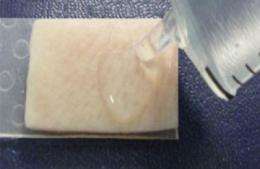Sticky solution for surgical sealants

(Medical Xpress) -- A Monash University researcher has developed a new form of surgical sealant that is not only easier for surgeons to manipulate, allowing for a more effective application, but significantly reduces the risk of virus contamination.
Surgical sealants are wax or gel-like substances used with sutures to completely seal internal and external incisions after surgery. They are particularly important following lung or spinal operations, where air and cerebro-spinal fluid can leak through the suture holes, causing numerous complications.
Limiting these leaks results in reduced mortality rates, less post-operative pain and shorter hospital stays for patients.
Initial research on the new sealant formula, developed by Dr Qizhi Chen, and her team from the Department of Materials Engineering at Monash University, was recently published in the journal Soft Matter.
“To be effective, a sealant must be sticky enough to allow the suture line to heal underneath, flexible, to allow for the body’s movement, and able to be absorbed by the body to eliminate the need for a second operation.”
“We’ve conducted initial tests on the new sealant and the results are very promising.”
“The major advantage of our sealant is that there’s no risk of infection because it’s synthetic. It’s not developed from human blood extract, like the current sealants on the market,” said Dr Chen.
The most common form of sealants currently in use are composed of natural materials extracted from human blood, such as fibrin. Although the natural sealants promote wound healing, their use involves a serious risk of blood-borne disease contamination such as HIV/AIDS or Hepatitis B.
The other major advantage of Dr Chen’s synthetic formula is the ease of application.
“It can be pasted on as a liquid at 45 degrees celsius. This hardens into a flexible wax-like substance at body temperature. The surgeon has plenty of time to make sure the sealant is properly applied. Sealants currently in use can harden too quickly, meaning they’re not always applied as effectively as they could be. Our formula resolves this issue.”










.jpg)





